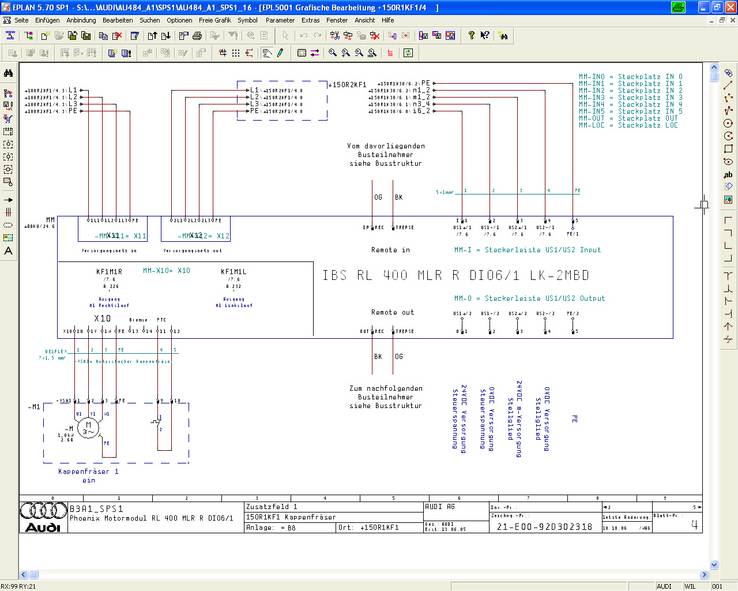Audi Toolmaking adopts new engineering philosophy
Automobile manufacturers Audi are proud of their reputation as a “Premium” brand. In keeping with this philosophy, the company’s in-house toolmaking division has now scored a unique triumph.
Automobile manufacturers Audi are proud of their reputation as a “Premium” brand. In keeping with this philosophy, the company’s in-house toolmaking division has now scored a unique triumph. Bucking the current trend for outsourcing, Audi has opted instead to insource its engineering on a new, mechatronic basis. The EPLAN Engineering Center will facilitate the highly efficient creation of a modular design system which will reduce plant development times to a fraction of the original, while at the same time boosting quality. A growing number of new Audi models are being on the market at ever shorter intervals, and the company is continually exploring new niches. Within this highly successful model strategy, Audi is also planning to significantly increase its vehicle production in the long term. The consequence of this development is shorter plant production times, from the initiation of the planning phase through to the start of production. In other words, the entire plant generation process must be optimized in order to meet these requirements. Given the growing importance of automation technology, Audi Toolmaking views bodywork production lines as mechatronic systems. Audi Toolmaking has responded to the latest development for automation engineering in plant production by setting up its own electronic design department. The Toolmaking division is in direct competition with external suppliers. “In order to ensure that our reputation as a premium brand extends to this area as well, we have devised a range of new strategies within project design", explains Jürgen Wilhelmy, in charge of electrical design. Mechatronic engineering
In the past, schematic generation and PLC programming for each plant was a largely manual process. In addition to the mechanical assemblies such as jigs and fixtures, the individual electrical circuits and PLC programs were project-planned in a subsequent stage. One of the aims of plant design at Audi Toolmaking is to create a modular mechatronic design system with a high level of modular standardization. In the hunt for a suitable tool to facilitate the modular generation of schematics and PLC programs, Jürgen Wilhelmy and his team analyzed a range of different suppliers and their products. It soon became clear that the innovative mechatronic engineering methods of the EPLAN Engineering Center from EPLAN met the Audi Toolmaking division’s requirements in full. The pilot project, involving bodywork production lines for the Audi TT, kicked off in January 2005. “From the very first project, we were impressed by way that PLC programs, pneumatic diagrams and electrical schematics were linked together in a modular mechatronic system”, explains Frank Herzog, Head of Tools and Equipment Manufacturing Design at the Audi Toolmaking division. “Our project planning is based on reusable mechatronic function modules which are then automatically linked to an overall design by the EEC via sets of rules”. An example from mechatronic engineering illustrates this principle: The “gripper” function of a robot is stored as a component in the modular design system, because the basic technical principle is always the same. It is only the parameterization of the design which ultimately determines the precise design of the gripper (number of tension jacks, grouping to valves etc.). Following this principle, each mechanical assembly is linked to the relevant pneumatic and electrical schematics and the PLC modules to form a mechatronic component. “Unlike the gradual evolution of that has occurred in the past, we believe that our new working method represents a quantum leap forward in the engineering process of tools and equipment manufacturing”, adds Frank Herzog. Huge time savings, thanks to parallelization and automation
In the past, the mechanical design was followed by the pneumatic diagram, then the electrical schematic, and finally the PLC program. Audi Toolmaking have revolutionized this once-sequential process. Project planning times are dramatically reduced thanks to parallelization and consistent reuse (see chart), enabling the design team to respond flexibly to changes, even at the last minute. This is Audi Toolmaking’s respondse to demands to build more production equipment in a shorter period of time.Premium quality through standardization and reuse
Jürgen Wilhelmy adds, “This approach has enabled us to secure a competitive lead! Qualified consultants at EPLAN assisted us with our first project at the beginning of 2005. Even at this early phase, during generation of the modular design system, the first positive effects were soon felt in project planning. Generation of the modular system is an ongoing process, because all amendments to modules are incorporated. In order for this approach to be successful, one of the basic requirements was that the tool used should be capable of emulating any given variant in the schematic or PLC standard. One of the major benefits of the EEC is the fact that it has been designed as an open system with a high level of interface transparency, making it much easier to integrate different engineering systems and their data into the mechatronic engineering process.”Summary
Audi Toolmaking has responded to shorter plant production times with the development and introduction of a mechatronic engineering process. Frank Herzog summarizes: “Not only has this approach made us faster and therefore more competitive; we have also managed to significantly enhance the quality of our design documents. As a result, the commissioning times for the production lines have been shortened. We are aiming to introduce the mechatronic engineering process throughout all our bodywork manufacturing operations. Another consequence of this new engineering method is that we have been able to create a number of highly qualified jobs with a secure long-term future." In 2006, Audi Toolmaking handled an equipment volume including more than 500 robots, most of it using the modular mechatronic system. The system is currently being expanded to include a virtual commissioning feature. Soon, it will be possible to automatically generate simulation models for the PLC. In a subsequent development stage, the system will be linked to the planning tools of the digital factory, to allow 100 percent data integration.





